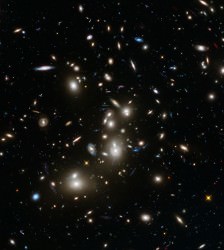This star is X light-years away, that galaxy is X million light-years away. That beginning the Universe is X billion light-years away. But how do astronomers know?
I’m perpetually in a state where I’m talking about objects which are unimaginably far away. It’s pretty much impossible to imagine how huge some our Universe is. Our brains can comprehend the distances around us, sort of, especially when we’ve got a pile of tools to help. We can measure our height with a tape measure, or the distance along the ground using an odometer. We can get a feel for how far away 100 kilometers is because we can drive it in a pretty short period of time.
But space is really big, and for most of us, our brains can’t comprehend the full awesomeness of the cosmos, let alone measure it. So how do astronomers figure out how far away everything is? How do they know how far away planets, stars, galaxies, and even the edge of the observable Universe is? Assuming it’s all trickery? You’re bang on.
Astronomers have a bag of remarkably clever tricks and techniques to measure distance in the Universe. For them, different distances require a different methodologies. Up close, they use trigonometry, using differences in angles to puzzle out distances. They also use a variety of standard candles, those are bright objects that generate a consistent amount of light, so you can tell how far away they are. At the furthest distances, astronomers use expansion of space itself to detect distances.
Fortunately, each of these methods overlap. So you can use trigonometry to test out the closest standard candles. And you can use the most distant standard candles to verify the biggest tools. Around our Solar System, and in our neighborhood of the galaxy, astronomers use trigonometry to discover the distance to objects.
They measure the location of a star in the sky at one point of the year, and then measure again 6 months later when the Earth is on the opposite side of the Solar System. The star will have moved a tiny amount in the sky, known as parallax. Because we know the distance from one side of the Earth’s orbit to the other, we can calculate the angles, and compute the distance to the star.
I’m sure you can spot the flaw, this method falls apart when the distance is so great that the star doesn’t appear to move at all. Fortunately, astronomers shift to a different method, observing a standard candle known as a Cepheid variable. These Cepheids are special stars that dim and brighten in a known pattern. If you can measure how quickly a Cepheid pulses, you can calculate its true luminosity, and therefore its distance.

Cepheids let you measure distances to nearby galaxies. Out beyond a few dozen megaparsecs, you need another tool: supernovae. In a very special type of binary star system, one star dies and becomes a white dwarf, while the other star lives on. The white dwarf begins to feed material off the partner star until it hits exactly 1.4 times the mass of the Sun. At this point, it detonates as a Type 1A supernova, generating an explosion that can be seen halfway across the Universe. Because these stars always explode with exactly the same amount of material, we can detect how far away they are, and therefore their absolute brightness.
At the greatest scales, astronomers use the Hubble Constant. This is the discovery by Edwin Hubble that the Universe is expanding in all directions. The further you look, the faster galaxies are speeding away from us. By measuring the redshift of light from a galaxy, you can tell how fast it’s moving away from us, and thus its approximate distance. At the very end of this scale is the Cosmic Microwave Background Radiation, the edge of the observable Universe, and the limit of how far we can see.
Astronomers are always looking for new types of standard candles, and have discovered all kinds of clever ways to measure distance. They measure the clustering of galaxies, beams of microwave radiation from stars, and the surface of red giant stars – all in the hopes of verifying the cosmic distance ladder. Measuring distance has been one of the toughest problems for astronomers to crack and their solutions have been absolutely ingenious. Thanks to them, we can have a sense of scale for the cosmos around us.
What concept in astronomy do you have the hardest time holding in your brain? Tell us, in the comments below.
And if you like what you see, come check out our Patreon page and find out how you can get these videos early while helping us bring you more great content!

